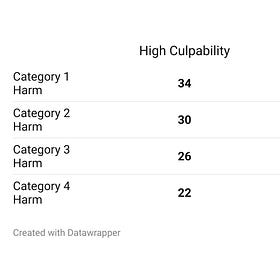The Failure of Drug Sentencing Policy Reform
The fourth in a series of essays on the 2024-25 U.S. Sentencing Commission guideline amendment year
On November 20, 2024, the U.S. Sentencing Commission held a Drug Sentencing Policy Roundtable, in Washington, D.C. The Roundtable was part of the Commission’s 2024-25 guideline amendment year, which coincided with the 40th anniversary of the Sentencing Reform Act. Among the Commission’s stated goals for the amendment year was “to examine whether the guidelines continue to achieve the Act’s statutory goals, such as meeting the purposes of sentencing as set forth in 18 U.S.C. § 3553(a)(2), bringing certainty and fairness to sentencing, avoiding unwarranted sentencing disparities, and reflecting advancement in knowledge of human behavior.”
This was certainly a bold and expansive goal, and the Drug Sentencing Policy Roundtable was a natural outgrowth of it, for the sentencing guideline for drug trafficking offenses, §2D1.1, has been, for decades now, one of the most frequently applied guidelines. It directly impacts nearly 19,000 people each year who are sentenced for drug trafficking offenses, and indirectly impacts tens of thousands more, of family members and loved ones of those sentenced. And as importantly, among the guidelines, no single one has been more criticized over the last 35 years than §2D1.1.
For many judges, practitioners, advocates, academics, and commissioners, the guideline simply relies too heavily on the type and weight of the drugs involved in the offense in determining the recommended sentence for drug offenders. This reliance leads to unintended and bizarre sentencing outcomes not infrequently. In addition, the drug guideline is a prime example of “factor creep,” the phenomenon of an ever-growing number of aggravating and mitigating factors added by Congress and the Commission to the Guidelines over time.
For the Roundtable, the Commission invited a group of practitioners, judges, academics, and others to discuss possible revisions to §2D1.1. The Commission stated that the “goal of this event is to think broadly about how the Commission can best achieve its statutory goals in sentencing individuals convicted of drug trafficking.” I was honored to be invited and to participate in the Roundtable, and I was happy to “think broadly.”
With the Commission’s ambitious goals in mind, I drafted and published what I believe is a better drug guideline than the one currently in the Guidelines Manual. The proposal doesn’t just tinker with the existing guideline; it is a restructuring. Because my hope is to see reform enacted and not just discussed, the guideline was drafted to garner bipartisan and widespread support, not just to fully satisfy my own thinking or anyone else’s. The proposal indeed did not fully satisfy advocates, or maybe anyone. Here it is, in full text and with an essay that follows explaining the idea and the thinking that went into it in greater detail.
A Better Federal Drug Guideline
§2D1.1. Unlawful Manufacturing, Importing, Exporting, or Trafficking (Including Possession with Intent to Commit These Offenses); Attempt or Conspiracy
The reformed guideline is an attempt to reflect congressional drug sentencing policy choices — for congressional support is important for long-term federal policy success — to better account for culpability that is not tied to drug type and weight — as this directly addresses the most important and legitimate criticism of the current guideline — to comply with the requirements of the Sentencing Reform Act, and to simplify the guideline too. In putting it forward, my goal was to begin a conversation that might lead to some genuine improvement and a new path forward for the Guidelines.
But just a few months later on January 24, 2025, the Commission published its proposed amendment to §2D1.1 for public comment, and frankly, it was quite disappointing. The proposal was not in line with the bold vision the Commission had telegraphed earlier in the amendment year. The proposed amendment had five parts, A through E. Part A addressed federal drug sentencing policy as a whole, with two proposed changes. Parts B – E addressed more granular policy with proposed changes to the drug guideline for cases involving two specific drug types, around the use of machineguns in drug crimes, and in relation to the so-called safety valve provision. The heart of the proposal was Part A, and it would simply lower drug penalties. Subpart 1 would reduce the base offense level for drug trafficking offenses involving the greatest amounts of drugs, and Subpart 2 would add a new specific offense characteristic providing for a sentence reduction for low-level drug trafficking functions.
My disappointment in the proposal was not because I think guideline drug penalties are set at the appropriate level of severity. Rather, my concern was that the proposal was too small and simple, and at the same time insufficiently sensitive to the politics of drug sentencing policy. Simply lowering drug penalties for those trafficking in the greatest amount of drugs — when the President has literally suggested the death penalty for drug dealers — seemed hopelessly tone deaf.
A different and more viable approach – one embodied in the proposal published here in October – would reform the drug guideline with a bit more nuance and care. It would not reject congressional drug sentencing policy, but would address the heart of the legitimate concerns with current policy. It would reflect a simplified guideline architecture that is more consistent with a post-Booker advisory guideline system; could be a model for further guideline simplification and reform; and would improve the drug guideline in a manner that could be supported broadly in Congress, by the Judiciary, and by other criminal justice stakeholders.
Unfortunately, the Commission’s proposal doubled down on the current guideline structure. And as a result, it was viewed by many as simply an attempt to reduce penalties, rather than an effort to recalibrate them to better differentiate those offenders who warrant long prison sentences from those who don’t. It was not at all surprising that the Trump Justice Department strongly opposed the proposal. But more importantly, the Criminal Law Committee of the Judicial Conference – a diverse group of federal judges from across the country – expressed concern with it and could not support the proposal either. In its written comments to the Commission, the Committee said –
Although the guideline ranges may be too high in some instances, especially for some lower-culpability drug defendants, reducing the highest base offense level across-the-board may not be the best way to accomplish the Commission’s goals and serve the purposes of sentencing. The Committee is concerned that an across-the-board reduction of Base Offense Level (BOL) 38 — whether to Level 34 (Option 1), 32 (Option 2), or 30 (Option 3) — may result in reductions that are too substantial and not warranted for the highest-level manufacturers and traffickers. The reduction also would conflate the sentencing ranges for the most culpable drug traffickers – that is, those deserving of the most punishment and deterrence – with those for less culpable defendants.
The Committee recommended that the Commission go back to the drawing board and suggested considering a proposal not unlike the proposal published here in October. As for the Justice Department, it summed up its opposition to the Commission’s proposal this way —
[The proposed reductions] would be inconsistent with Congress’ intent, untether the Guidelines from statutory penalties, and be inconsistent with the ongoing public safety and public health crisis stemming from synthetic opioids, drug trafficking by cartels, and other emerging narcotics threats.
Given the opposition of two branches of the federal government to the published proposal, not surprisingly, on Friday, April 11, 2025, the Commission completed its guideline amendment without adopting any fundamental reform to the drug guideline. It did take steps to ensure that drug offenders who play a mitigating role — a small percentage of the total — are not over-punished. But the Commission has tried this before — numerous times, in fact — and it is far from clear that the steps taken will make any significant difference in drug sentencing policy.
The Commission not only made no fundamental reforms to drug sentencing, it also did not address the unwarranted disparities in methamphetamine sentencing identified by numerous commentors early in the amendment year. This seemed especially perplexing given Commission Chair Reeves' own detailed decision in United States v. Robinson, holding that the methamphetamine purity enhancement had ceased to have any meaning.
It was a disappointing end to an amendment year that began with high hopes. Perhaps most disappointing was that there was no discussion at the public April Commission meeting of the Commission’s thinking and how it arrived at its decisions. A few weeks later, when the Commission submitted the year’s guideline amendments to Congress, it included this “reason for amendment” with its amendment to §2D1.1 —
This two-part amendment is the result of the Commission study on the operation of §2D1.1 (Unlawful Manufacturing, Importing, Exporting, or Trafficking (Including Possession with Intent to Commit These Offenses); Attempt or Conspiracy). As part of its study, the Commission considered feedback from the field, including at a roundtable discussion on drug sentencing, a public hearing, and public comment. The Commission also analyzed a range of drug trafficking sentencing data, including data on sentences imposed at the highest base offense levels, the application of the “mitigating role cap” and mitigating role adjustment, sentences imposed based on function, and the application of enhancements in fentanyl and fentanyl analogue cases. The Commission determined that targeted changes were warranted to ensure appropriate penalties commensurate with an individual’s function in a drug trafficking offense and to better address the harms of representing or marketing fentanyl or a fentanyl analogue as a legitimately manufactured drug.
The public deserves a better explanation of the Commission’s thinking and for the Commission’s actions and inactions. The Commission spent two and half days in deliberations behind closed doors before its April vote, but then in its public meeting of less than a half hour, explained nothing of how those deliberations resulted in the actions taken and not taken.
Judges, practitioners, Members of Congress, advocates, inmates, family members, and academics spent countless hours developing and submitting written comments to the Commission, and some traveled across the country — or just took time — to attend the Drug Sentencing Policy Roundtable. Yet there was virtually no discussion of how those written and Roundtable comments were considered. Moreover, without more, it’s hard to know whether the Commission might consider further reforms to federal drug sentencing policy in the years ahead or how proposals might be developed to garner greater commissioner support.
I still hope the drug guideline can be reformed. But to do so, the Commission will have to show some greater political savvy, developing a reform proposal that is not — and cannot be summarized as — simply lowering penalties, one that reflects Congress’ continuing belief that drug type and quantity have a place in the drug sentencing algorithm, and one that breaks out of the rigid guideline structure adopted almost 40 years ago by the Commission. I published my attempt at that back in October, and I believe it is worthy of further consideration.




